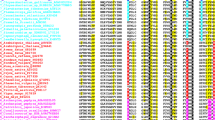Abstract
The relationship between the net charge ofmolecules and their mobility on electrophoresis wasanalyzed for Drosophila alpha-amylases. Most ofthe differences in electrophoretic mobility, 98.2%, canbe explained by the charge state. Therefore fivereference amino acid sites, which are informativeresidues for charge differences among amylase isozymes,were considered for the evolution of the isozymes in Drosophila melanogaster. Theamylase isozymes in D. melanogaster can beclassified into three groups, I (AMY1,AMY2, and AMY3-A), II(AMY3-B and AMY4), and III(AMY5, AMY6-A, andAMY6-B), based on the differences in the reference sites. The mostprimitive amylase in D. melanogaster was foundto belong to Group I, most likely the AMY2isozyme. Groups II and III could have been derived fromGroup I. These results were confirmed by the analysis of 38amino acid sites with charge differences inDrosophila.
Similar content being viewed by others
REFERENCES
Bahn, E. (1967). Crossing over in the chromosomal region determining amylase isozymes in Drosophila melanogaster. Hereditas 58:1.
Barbadilla, A., King, L. M., and Lewontin, R. C. (1996). What does electrophoretic variation tell us about protein variation? Mol. Biol. Evol. 13:427.
Brown, C. J., Aquadro, C. F., and Anderson, W. W. (1990). DNA sequence evolution of the amylase multigene family in Drosophila pseudoobscura. Genetics 126:131.
Dainou, O. M. L., Cariou, J. M., Goux, J. M. and David, J. R. (1993). Amylase polymorphism in Drosophila melanogaster: Haplotype frequencies in tropical African and American populations. Genet. Sel. Evol. 25:133.
Da Lage, J. L., Lemeunier, F., Cariou, M. L., and David, J. R. (1992). Multiple amylase genes in Drosophila ananassae and related species. Genet. Res. 5:85.
Doane, W.W. (1967). Quantitation of amylases in Drosophila separated by acrylamide gel electrophoresis. J. Exp. Zool. 164:363.
Doane, W. W. (1969a). Amylase variants in Drosophila melanogaster. Linkage studies and characterization of enzyme extracts. J. Exp. Zool. 171:321.
Doane, W. W. (1969b). Drosophila amylase and problems in cellular differentiation. In Hanley, E. W. (ed.), RNA in Development, University of Utah Press, Salt Lake City.
Hickey, D. A., Bally-Cuif, L., Abukashawa, S., Payant, V., and Benkel, B. F. (1991). Concerted evolution of duplicated protein-coding genes in Drosophila. Proc. Natl. Acad. Sci. USA 88:1611.
Inomata, N., Shibata, H., Okuyama, E., and Yamazaki, T. (1995). Evolutionary relationships and sequence variation of α-amylase variants encoded by duplicated genes in the Amy locus of Drosophila melanogaster. Genetics 141:237.
Johnson, G. B. (1977). Evaluation of the stepwise mutation model of electrophoretic mobility: Comparison of the gel sieving behavior of alleles at the esterase-5 locus of Drosophila pseudoobscura. Genetics 87:139.
Keith, T. P., Brooks, L. D., Lewontin, R. C., Martinez-Cruzado, J. C., and Rigby, D. L. (1985). Nearly identical distributions of xanthine dehydrogenase in two populations of Drosophila pseudoobscura. Mol. Biol. Evol. 2:206.
Kikkawa, H. (1960). Further studies on the genetic control of amylase in Drosophila melanogaster. Jap. J. Genet. 35:382.
Kikkawa, H. (1964). An electrophoretic study on amylase in Drosophila melanogaster. Jpn. J. Genet. 39:401.
Kreitman, M. (1983). Nucleotide polymorphism at the alcohol dehydrogenase locus of Drosophila melanogaster. Nature 304:412.
Lewontin, R. C. (1974). The Genetic Basis of Evolutionary Change, Columbia University Press, New York.
Lewontin, R. C., and Hubby, J. L. (1966). A molecular approach to the study of genic heterozygosity in natural populations. II. Amount of variation and degree of heterozygosity in natural populations of Drosophila pseudoobscura. Genetics 54:595.
Magoulas, C., Loverre-Chyurlia, A., Abukashawa, S., Bally-Cuif, L., and Hickey, D. A. (1993). Functional conservation of a glucose-repressible amylase gene promoter from Drosophila virilis in Drosophila melanogaster. J. Mol. Evol. 36:234.
Matsuo, Y., and Yamazaki, T. (1984). Genetic analysis of natural populations of Drosophila melanogaster in Japan. IV. Natural selection on the inducibility, but not on the structural genes, of amylase loci. Genetics 108:879.
Matsuo, Y., and Yamazaki, T. (1986). Genetic analysis of natural populations of Drosophila melanogaster in Japan. VI. Differential regulation of duplicated amylase loci and degree of dominance of amylase activity in different environments. Jpn. J. Genet. 61:543.
Matsuo, Y., and Yamazaki, T. (1997). Genetic factors on the second and third chromosomes responsible for the variation of amylase activity and inducibility in Drosophila melanogaster. Genet. Res. 70:97.
Milanovic, M., and Andjelkovic, M. (1993). Biochemical and genetic diversity of alpha-amylase in Drosophila. Arch. Biol. Sci. Belgrade 45:63.
Ohta, T., and Kimura, M. (1973). A model of mutation appropriate to estimate the number of electrophoretically detectable alleles in a finite population. Genet. Res. 22:201.
Payant, V., Abukashawa, S., Sasseville, M., Benkel, B. F., Hickey, D. A., and David, J. (1988). Evolutionary conservation of the chromosomal configuration and regulation of amylase genes among eight species of the Drosophila melanogaster species subgroup. Mol. Biol. Evol. 5:560.
Popadic, A., and Anderson, W. W. (1995). Evidence for gene conversion in the amylase multigene family of Drosophila pseudoobscura. Mol. Biol. Evol. 12:564.
Ramshaw, J. A. M., Coyne, J. A., and Lewontin, R. C. (1979). The sensitivity of gel electrophoresis as a detector of genetic variation. Genetics 93:1019.
Shibata, H., and Yamazaki, T. (1995). Molecular evolution of the duplicated Amy locus in the Drosophila melanogaster species subgroup: Concerted evolution only in the coding region and an excess of nonsynonymous substitutions in speciation. Genetics 141:223.
Swofford, D. L. (1993). PAUP: Phylogenetic Analysis Using Parsimony, Version 3.1.1, Illinois Natural History Survey, Champaign.
Veuille, M., and King, L. M. (1995). Molecular basis of polymorphism at the esterase 5B locus in Drosophila pseudoobscura. Genetics 141:255.
Yamazaki, T., and Matsuo, Y. (1984). Genetic analysis of natural populations of Drosophila melanogaster in Japan. III. Genetic variability of inducing factors of amylase and fitness. Genetics 108:223.
Yamazaki, T., Matsuo, Y., Inoue, Y., and Matsuo, Y. (1984). Genetic analysis of natural populations of Drosophila melanogaster in Japan. I. Protein polymorphism, lethal gene, sterility gene, inversion plymorphism and linkage disequilibrium. Jpn. J. Genet. 59:33.
Rights and permissions
About this article
Cite this article
Matsuo, Y., Inomata, N. & Yamazaki, T. Evolution of the Amylase Isozymes in the Drosophila melanogaster Species Subgroup. Biochem Genet 37, 289–300 (1999). https://doi.org/10.1023/A:1018755109757
Issue Date:
DOI: https://doi.org/10.1023/A:1018755109757




